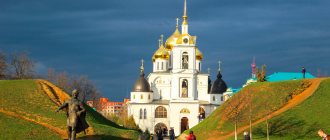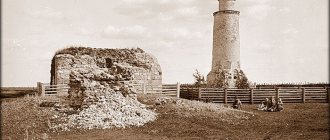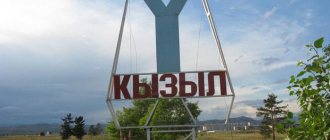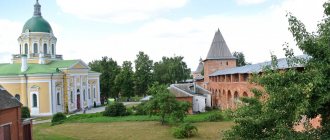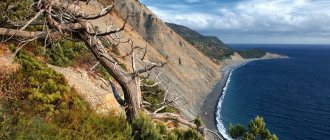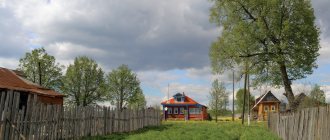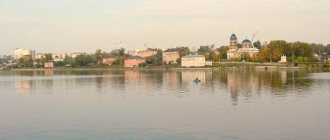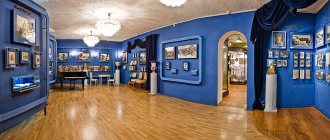We have symbolic places in Russia.
Even if you have never been there, the name itself is firmly imprinted in your heart. One of these places is located in the Belgorod region. This is the legendary Prokhorovka. It was here that the largest tank battle of World War II took place in July 1943. And in this essay I want to talk about the famous Tank Field.
Click on the photos and they will open in larger format
Museum-reserve "Prokhorovskoye Field". Brief overview and tips for those wishing to visit: muph
Last May, I very actively traveled to places associated with the tragic events of the Great Patriotic War. I managed to talk about some of them on the blog, but not yet about others. Why? Well, firstly, this topic is very difficult for me to write, both morally and technically, and secondly, many citizens of the Russian Federation remember the Second World War only when Victory Day and related weekends approach. And during the year they try not to bother themselves with patriotism and terrible details of military operations. Accordingly, there is no interest and then simply no one reads the posts, and the statistics do not show even half of the average views for my blog. It is for these two reasons that quite a lot of photographic material lay on the hard drive for almost a year. But spring is in full swing, many will go on various trips during the May holidays and, perhaps, even stop somewhere along the way to honor the memory of soldiers and officers who fell in battle. For example, in Prokhorovka, where on July 12, 1943, during the defensive phase of the Battle of Kursk, one of the largest battles in military history using armored forces took place.
In this post I will give an overview of what you can see in Prokhorovka, where to stay the night, eat, and so on. And, of course, as briefly as possible (after all, May 9 is still far away) I’ll tell you about the meat grinder that happened here in the summer of 1943.
So, in the north of the Belgorod region, the urban-type settlement of Prokhorovka. In fairness, it is worth noting that the famous tank battle took place at the Prokhorovka railway station, named after the track engineer V.I. Prokhorov, and located a little to the side. Until 1968, this settlement was called the village of Aleksandrovskoye. In the post-war years, it grew and included the very Prokhorovka station, which became the western part of the village.
02. There are no hotels in Prokhorovka, except for the one you see in the photo below, so I recommend booking rooms in advance through the website of the Prokhorovskoye Pole hotel complex. The hotel is not bad, especially for a provincial one. The only bad thing is the organization of meals for guests. Breakfast is extremely slow, and we didn’t get to have dinner at all, because the hotel restaurant closes very early. We wanted to take a walk at sunset. However, catering is bad everywhere in Prokhorovka. More than 9 thousand people live in the village, there is a sports complex, a cinema, an elevator, factories, but there is nowhere to eat. We raided three cafes that the hotel administrator recommended to us, and as a result, one was hosting a wedding, another served only beer and snacks, and the third was completely closed. Therefore, we had to improvise in the room ourselves. We had a three-year-old daughter with us, who didn’t really want to feed sandwiches at night.
03. Near the hotel parking lot there is a sculptural group “Tankman and Infantryman”. It is clear that the role of infantry in a tank duel was the most unenviable and essentially suicidal.
04. Almost opposite the hotel complex there is a huge building of the Museum of Military Glory “The Third Military Field of Russia”.
05. The building was opened on May 2, 2010. Outwardly, it resembles an arc, lined with gray granite, and the main façade, as conceived by the architect, imitates tank tracks.
06. A sculptural composition that struck me to the core. Two Soviet and three life-size German tanks collided in a powerful ram. They write on the Internet that you can climb into one of the tanks and see a defeated fascist there, but they open this door, as I understand it, only for large organized groups.
06. Traditionally, Soviet sources indicate that about 1,500 tanks took part in the Battle of Prokhorovka. 800 Soviet and 700 German. Some modern historians claim that there were fewer tanks, but looking at this monument, I can’t even imagine what kind of hell was going on here then.
07. To the right of the museum building is the rather unusual Church of Peter and Paul.
08. Remake. Built for the 50th anniversary of the Great Victory.
09. In the courtyard there is also a small St. Nicholas Church, etc. "Bell of Unity" This is a monument erected as a symbol of the unity of three Slavic peoples: Belarus, Russia and Ukraine. Opened on the anniversary of the 55th Victory Day. Patriarch Alexy II, Putin, Kuchma and Lukashenko were present at the opening.
10. By evening light we drove from the village, actually, to the battlefield. Now bread grows on it every day, but how much blood it once absorbed...
11. Height 252.2 is marked by a belfry.
12. The height of the belfry itself is 59 meters. Inside, under the dome, there is an alarm bell weighing 3.5 tons, and on 4 wall pylons there are 24 high reliefs with 130 images. I am specially publishing photos in large size so that you can appreciate this work of art and the main monument of the entire Prokhorovskoe Field memorial complex.
13. A little further away they erected a monument to one of its creators - sculptor Vyacheslav Klykov. He died in 2006
14. Nearby is another sculptural group - “Great commanders of the three military fields of Russia - Dmitry Donskoy, Mikhail Kutuzov, Georgy Zhukov.”
15. And, of course, tanks.
16. More precisely, tanks, Katyushas, guns and other military equipment from the times of the Great Patriotic War.
17. T-34-85 and my favorite Vikushonok.
18. The next morning we continued our inspection of Prokhorovka. We had breakfast, checked out of the hotel and went to the museum.
19. But first they walked around him in a circle. Behind the building there was a rather interesting exhibition showing a fragment of the defense line: trenches and enemy equipment in positions.
20. Almost all German equipment was melted down in the post-war years, so the German tank is represented only by a turret on a stand.
21. Shortly before our arrival, next to the museum, another monument was opened for the 70th anniversary of the Victory, called “Tank Landing”. Work was in full swing around it to improve the territory (we were in Prokhorovka on May 1) and by the ninth there was still a lot to be done.
22. Work also took place at another exhibition site of military equipment, where 12 of the most significant vehicles in the history of armored vehicles were presented, through which the main stages of the development of armored vehicles and tank weapons can be traced. In addition, on May 9, the opening of a tankodrome with an obstacle course, stands for spectators with 1,300 seats, and other things was supposed to take place. It’s a pity that we weren’t able to see the tank show, but it will give us a reason to come back someday.
23. In general, then we go to inspect the museum exhibition. It is huge and perhaps I will talk about it in a separate post, but now just a couple of fragments. An excellent interactive map of attractions in the Belgorod region. It can be seen that now the belfry and the Cathedral of Peter and Paul are highlighted on it, but if you turn on another area on the multimedia screen next to the map, then other objects will be highlighted, and you can read general information on the monitor. Very cool, in my opinion.
24. I note that everything in the museum is very modern and interactive. There is no typical museum “mothball” feeling, if you know what I mean.
25. Although not without some complications, as it turned out. In front of me, one of the spectators puzzled the guide with a question about some discrepancy between a detail of the soldier’s uniform (I don’t remember what exactly) and the 1943 uniform. The woman was embarrassed and said that the stands were made and decorated by some Moscow office and in a very fast manner, so there may be slight discrepancies.
26. And finally, let’s return to the topic of public catering in Prokhorovka. Not far from the belfry there is a rather interesting themed cafe “Blindage”. In general, I give the establishment a “pass” (a wooden jukebox with songs from the war years and artillery shell casings as vases for wildflowers are five!), but in the evening of the first day it was already closed, and at lunchtime on the second day almost the entire ration was eaten.
27. In particular, there was not enough foie gras potatoes. The last portion was grabbed for our daughter (the cook scraped the bottom of the barrel for the little girl), and Lena and I took the less popular millet for ourselves. I note that landscaping work was also going on around the “Dugout” and it is quite possible that another cafe appeared nearby. At least there is an o on Wikimapia, so I hope that people who, on my advice, go to Prokhorovka will not remain hungry.
28. After lunch we went to see the observation post of the commander of the 5th Guards Tank Army, General Rotmistrov. It was from here that the command of the Prokhorovsky battle was exercised. Alas, there was a lock on the door and we had to limit ourselves to only an external inspection. After that, our program included a beautiful windmill in the village of Yakovlevo, a monument to the fighter pilot Gorovets and another interesting memorial complex dedicated to the Battle of Kursk, the “Arc of Fire,” which I will also definitely tell you about.
I hope the post was interesting. Let's remember.
————————— Subscribe to blog updatesAdd yourself! On social networks I publish announcements of new posts, and on Instagram - the most beautiful photos!
The use of my photographs in any media, printed materials and on any websites, with the exception of personal blogs and pages on social networks, is PROHIBITED. Only after agreement with me. I remind other copy-pastors that when reprinting photographs and text, an active indexed link to the source is required!
muph.livejournal.com
Tank field
a sign at the very entrance to the Tank Field . And you immediately understand that this is not just a field, but the territory of a museum-reserve.
Nearby is a stela with the Decree of the President of the Russian Federation B.N. Yeltsin on the creation of the Prokhorovskoe Field museum-reserve. And from this place there is a beautiful view of the belfry.
The lawns on the field are decorated in the style of the St. George Ribbon.
From a distance the belfry looks like a lit candle. The four pylons (side walls) symbolize the four years of war. The golden sphere represents the sun and power, a symbol of statehood. And above her is the figure of the Most Holy Theotokos, intercessor and defender of Russia.
Inside the Belfry, under the drum, a bell weighing 3.5 tons is suspended. It sounds three times an hour , notifying with blows the great role of the three battlefields in the history of Russia.
- The first ringing reminds us of the heroes of the Kulikovo field, when Russia was freed from the Mongol-Tatar yoke.
- The second ringing is the memory of the Battle of Borodino, when the invasion of Napoleonic troops was stopped.
- The third ringing is the memory of the Battle of Prokhorov. It became one of the turning points in the fight against Nazi Germany.
There are a lot of symbols on this monument related not only to the tank battle of 1943, but also to the history of our country. You can read about this in a separate essay, which is dedicated to the Belfry on the Prokhorovsky Field.
Next to the Belfry there are busts of three Russian commanders. Dmitry Donskoy led the Russian army on the Kulikovo field, Mikhail Illarionovich Kutuzov - on Borodino, and Georgy Konstantinovich Zhukov - near Prokhorovka. Here it is, the connection of times!
Next to them is a stylized map depicting the territory of three military fields of Russia: Kulikov, Borodino and Prokhorovsky.
And behind them, in a vast space, there are tanks, self-propelled guns, and artillery installations.
Information plates indicate the main characteristics of combat vehicles and artillery pieces. This is what our famous “thirty-four” of 1943 was like.
In the depths of the field, among the trees, stands a tank number 213 with a guards badge on the left side . It is considered the very first monument on the Tank Field. In 1973, the tank entered the pedestal under its own power and froze forever at this height. There are several pictures of this tank in my archive. This is what he looked like in July 2014.
And this is a photo from April 9, 2022. As you can see, the side inscriptions on the tank, the information plate, and the lining of the pedestal have been updated.
There is an amazing story connected with this tank.
In November 2022, a reader from the Sverdlovsk region, Valery Vladimirovich Varov, came to my project. Since childhood, he knew that his father was a driver-mechanic on tank number 213. Valery Vladimirovich always watched newsreels and feature films in the hope of seeing his father’s combat vehicle.
And then, in the Yandex photo feed, he accidentally came across a picture of a tank with this number. By clicking on the link, Valery Vladimirovich went to the “Roads of the Soul” website. I wrote a comment and I replied.
We started correspondence. Valery Vladimirovich shared photographs from the family archive (they are in the comments after this article). We discussed many issues related to the Battle of Kursk. And at some point we realized that we definitely needed to go to the Tank Field.
We arrived in Belgorod: I by train from Vladimir, Valery Vladimirovich by plane from Yekaterinburg. On April 9, 2022, we met in Prokhorovka near tank number 213.
During my stay in Prokhorovka, many interesting and rather unexpected facts related to this tank were revealed. Valery Vladimirovich shared this information in an interview that he gave to our project.
Next to the pedestal on which the tank stands, in 1943 there was a defense line.
On the tank field you can see the legendary Katyusha.
At the other end of the field next to the track there is a cafe "Dugout" .
The menu in the cafe is also “front-line”.
Prokhorovka. Third battlefield | Travel Club Lucas Tour
Everyone always looks forward to the May holidays. Sun, warmth, great mood, May 1st, after all! Heading on the road! This time our path went to the Belgorod region, the village of Prokhorovka. Here, during the Great Patriotic War, the largest tank battle took place. On July 12, 1943, the armies of Manstein and two Soviet armies—the 5th Guards and 5th Guards Tank Army—came together in battle. This was the most significant battle of the Oryol-Kursk Bulge.
All along the same beloved M2 highway, we set off towards Kursk. The weather got better and better! The road was pleasing to the eye with landscapes and excellent surface. Having entered the Belgorod region, we drove another hour to the sign in the village of Yakovlevo, and there we were already very close to the memorial. The entire journey from the city of Orel to the village of Prokhorovka near Belgorod took 5 hours of pleasant time.
Before reaching the village itself, we saw a memorial. A huge space where samples of military equipment are located and there is a monument to those killed in this battle.
From afar, only as we approached, we noticed him. This monument is called "Belfry". It was installed for the 50th anniversary of the Victory in 1995. This stele is created in the form of a bell tower, more than 50 meters high, and a large bell hangs inside!
Believe me, it's impressive!
A T 34 tank stands on a hill to the side.
You can approach and touch all the combat vehicles and guns with your own hands. This is what many children and adults who visited the memorial at that moment were doing.
After being on the road for 5 hours, we wanted to grab a bite to eat. There is a café “Blindage” on site.
Interesting interior, very low prices.
But we didn’t enjoy the food. The menu included soldier's porridge, borscht, solyanka, tea, everything was just like in 1943. We could have taken something else, but we decided to try what soldier’s porridge is! No! This is not buckwheat with meat at all, as my daughter thought! It turned out to be salted millet in water with lard! Of course, I don’t mind 28 rubles, but it wasn’t very pleasant to eat. This was the only negative thing about our trip. We somehow satisfied our hunger.
After walking around the Field, we finally decided to get to the village itself. 10 minutes and we are there! In Prokhorovka, focusing on the domes of the church, we drove along the main road to a large museum, which is also called the “Third Battle Field”.
I kept thinking, why the Third Field? Then I understood! By scale of battles: First - Kulikovo Field, Second - Borodino and Third - Prokhorovka!
The museum is very large and interesting.
There are trenches dug in the yard, there are several dugouts (they were, however, closed), there are broken guns and shell casings lying around. Joy for children! Run along the passages and passages as much as you like!
In front of the entrance there is a monument called “Taran”.
Life-size tanks of the opposing sides collided head-on! Makes an amazing impression! Compared to them, you seem like a bug!
The museum has two floors, there are interactive screens where you can see how the disposition of enemy troops changed during the battle, and see the technical characteristics of the weapons of both sides.
There are 3D installations of uniforms from the Borodino era and award badges.
There is a display case where you can go up and pick up a rifle, pistol or machine gun, and feel the weight of one or another weapon.
On the second floor there is a room where you can play tanks.
In a small darkened corridor, themed films about the war are being shown. If you wish, if there are six of you, you can book an excursion.
In short, everything is interesting and for every taste. I think this place will not leave anyone indifferent and you will get a lot of impressions.
galina-lukas.ru
State Military Historical Museum-Reserve "Prokhorovskoe Field"
Prokhorovskoye Field is the site of a bloody battle that took place in 1943. This battle is also known as one of the largest tank battles in the history of World War II. And some military historians call it the largest battle using armored forces in general, outside the context of time.
During the defensive phase of the Battle of Kursk, the forces of the German and Soviet armies clashed in the Battle of Prokhorovka. The battle took place on July 12, 1943 in the south of the Kursk Bulge in the Belgorod direction in the Voronezh Front, not far from the Prokhorovka station (hence the name). The opponents fought on the territory of the Oktyabrsky state farm.
The tank formations were commanded by Lieutenant General Pavel Rotmistrov from the Soviet side and SS Oberstgruppenführer Paul Hausser from Nazi Germany.
The result of the battle did not bring satisfaction to either side. The Germans were unable to capture the strategically important point of Prokhorovka, and the Red Army was unable to gain operational space and was unable to encircle the enemy.
The following took part in the battle:
- From the Soviet Army: 5th Guards Tank Army and 5th Guards Army - 597 tanks and self-propelled artillery units, 130,000 people.
- From Nazi Germany: 2nd SS Panzer Corps - 311 tanks and self-propelled artillery units, 70,000 people.
A memorial museum-reserve in honor of the battle opened in Prokhorovka in 1995, on the 50th anniversary of the Great Victory of the Red Army over Nazi Germany.
Map of the Prokhorovskoe Field Museum-Reserve
Museums of Prokhorovsky Field
The main monument of the museum-reserve on Prokhorovsky Field is a 59-meter belfry, symbolizing Victory. It consists of 4 white stone pylons - one for each year of the war. At the top of the belfry there is a 7-meter sculpture of the Intercession of the Blessed Virgin Mary, the defender of Russia.
Also, everyone can see exhibits of military equipment near the Victory Monument. The exhibition is presented outdoors.
Also, as part of the military-historical museum-reserve “Prokhorovskoe Field” there are several exhibitions.
The Museum “The Third Military Field of Russia” tells about how the Prokhorovsky district lived during the war. The exhibition has been running since 2010 and occupies 5,000 square meters. Here you can see clothes, personal belongings, letters from soldiers, photographs of that time, and historical materials.
The Armored Vehicles Museum has an area of 2830 square meters. Open from January 27, 2022. Here you can learn the history of tank building - from ancient times to the present day. You will learn what the first tanks looked like and how different they are from modern ones. This is a spectacular exhibition, equipped to all modern standards. There are touch screens, installations, and even a model of Leonardo da Vinci’s tank. You can also see the “Factory” scene, which shows the stages of tank production. For lovers of military equipment, this is one of the most interesting museums in the region.
Also on the territory of the Prokhorovskoe Field museum-reserve you can see:
- Monument to Soviet tank crews;
- A memorial sign at the site of the feat of senior lieutenant P. I. Shpetny;
- There is a sculptural composition “Tank Landing”;
- And also the bell of unity of the Slavic peoples;
- The Temple of Peter and Paul was built on the territory of the museum-reserve (the day of celebration of these saints falls on July 12, when the battle took place). The names of 7 thousand soldiers who died here are carved on the marble slabs of the temple walls;
- A reconstructed observation post is in operation;
- There are also military graves here;
- Tankodrome;
- Library of N. I. Ryzhkov;
- Cultural and historical center (with a hotel, conference hall, museum cafe).
Virtual walk through the museum
Prices in the Prokhorovsky Field museums
You can find prices for visiting the museum, travel on armored vehicles and the cost of staying at a hotel on the territory of the museum-reserve on the official website. Prices change every year.
Prices in the Prokhorovsky Field museums
How to get to Prokhorovsky Field
It is easy to get to Prokhorovsky Field from Belgorod, the regional center. The road takes 60 km. It takes about an hour to travel by public transport. Buses, electric trains and even long-distance trains go to Prokhorovka several times a day.
You can also visit the museum-reserve by arriving as part of an excursion group.
Or you can order a taxi using one of the popular applications like Uber or Yandex.Taxi.
You can also come by your own car from Belgorod (the journey will not take more than 1–1.5 hours). The route map is shown below:
All transport along the route is on the Yandex website. Schedules.
Prokhorovskoe field from above
www.tourister.ru
Victory Park
Victory Park, which is adjacent to the Tank Field, was created quite recently. Do you recognize the model of the Reichstag with the Victory Banner raised above it? This is a photo from 2016.
Now the layout of the Reichstag roof looks like this.
In 2005, an apple orchard was founded near Victory Park.
We find ourselves on the central alley of the park.
There are steles on it telling about the bloody battle on the Kursk Bulge.
In Victory Park there are many monuments dedicated to the participants of the tank battle near Prokhorovka on July 11-12, 1943.
In the photo on the left is a monument to "Women of War" , in the photo on the right - to "Soldier Warrior" .
Monument to Soviet commanders who led the tank battle near Prokhorovka: I.S. Konev, A.M. Vasilevsky, N.F. Vatutin, K.K. Rokossovsky.
Monument to the commanders of the armies who participated in the Battle of Prokhorov: P.A. Rotmistrov, V.D. Kryuchenkin, A.S. Zhadov.
Here are two more monuments - “Lieutenants of War” and Pavel Ivanovich Shpetny.
of Lieutenant Borisov , who stopped several enemy tanks, is immortalized in Victory Park
The central path leads to the chapel, built at the expense of the Ryzhkov family.
The path from the chapel leads to the “Farewell” sculptural group. And I immediately remember the immortal lines of Konstantin Simonov: “Wait for me and I will return, just wait a lot...”.
A fragment of a military camp has been recreated nearby .
Here you can see models of trenches and dugouts.
The Prival cafe is located very close by
How can one not remember Vasily Terkin?
The power of the native land
I travel a lot. Somewhere I go with a guide, often on my own. In any case, I “scan” the space around me at all 360 degrees. That is, not only the objects that the guide talks about, but also much more come into view. Ordinary tourists are unlikely to pay attention to such “little things”, but my eyes already automatically read the space. I wrote about this in the essay “Tuning fork for traveling or how to tune into a place.”
So it was this time. When you arrive at the Tank Field, pay attention: in the place where the belfry rises and the tanks stand, there are no trees. And they are in Victory Park. And most of these trees grow in a very interesting way - several trunks from one root.
I have repeatedly heard from different people that this is one of the signs of a Place of Power. I think it was not for nothing that this particular field was chosen for the battle. The most powerful energy support from our native mother earth!
Memorial complex "Third Military Field of Russia"
A few kilometers from the Tank Field and Victory Park is Prokhorovka itself. And there is something to see there too.
In 1995, for the 50th anniversary of the Victory, in memory of those killed in the tank battle on July 12, 1943, the Church of the Holy Apostles Peter and Paul was erected in Prokhorovka. Next to the temple is the “Bell of Unity” , a symbol of friendship of three fraternal peoples - Russian, Ukrainian and Belarusian.
The cathedral was built in just a year using public donations. The temple has an interesting architectural element called “kokoshnik” . Every time I see kokoshniks on this temple (and I’ve been to Prokhorovka several times), a strange feeling comes over me from within. It’s as if the eyes of the soldiers who did not return from that terrible battle look straight into the soul.
In summer, the temple area is literally buried in flowers. Nearby there is a clergy house with a Sunday school and a library.
is located nearby .
In 2016, I saw a stele installed near the Cathedral of Peter and Paul. It contained a list of fronts and armies that took part in the Battle of Kursk. It’s strange, but in 2022 I no longer found this stele in its original place. Can you please tell me where it was moved?
The sculptural group “Taran” is located in front of the entrance to the memorial complex “Third Military Field of Russia”.
It has been more than 70 years since the battle ended. But to this day, finds from the war can still be found on the Prokhorovsky field. A few years ago they lay next to the museum building.
Here you can see German military vehicles Opel and Hanomag.
Behind the museum building there is a reconstructed fragment of Soviet and German defensive fortifications . They consisted of trenches, trenches, communication passages, platforms for guns and shelters for tanks. A real dugout is built into the trench system!
Now new museums have appeared in Prokhorovka - the Museum of Armored Vehicles and the Museum of Weapons.
I advise you to take a look
More detailed information about the State Military Historical Museum-Reserve “Prokhorovskoye Field” can be found on its official website.
Prokhorovka city, Belgorod region - travel on the map
Prokhorovka is an urban-type settlement (since 1968), the administrative center of the Prokhorovsky district of the Belgorod region of Russia.
Population - 9170 people. (2015).
Located in the north of the region, not far from the sources of the Psel River, 56 km from the regional center. Railway station on the Kursk - Belgorod line of the South-Eastern Railway.
Story
The first mention of the settlement in historical documents dates back to the second half of the 17th century. The Polish nobleman Kirill Grigoryevich Ilinsky (Ilinsky) from the Korczak family and his son Savva left Poland during the Russian-Polish war of 1654-1667 to Belgorod, where they founded the Ilinskaya settlement. In the 1860s, Ilyinskaya Sloboda was renamed in honor of the reigning Emperor Alexander II into the village of Aleksandrovskoye.
In the 1880s, the line of the Kursk-Kharkov-Azov Railway passed to the west of the village. At the same time, the Prokhorovka station was built, named after the track engineer V.I. Prokhorov, who was responsible for its construction.
During the Great Patriotic War, on July 12, 1943, in the area of the Prokhorovka railway station and the village of Aleksandrovskoye, the Battle of Prokhorovka took place - a major oncoming tank battle of the Second World War, where over 1,200 tanks and self-propelled guns took part on both sides.
In the post-war years, the village of Aleksandrovskoye grew and included the Prokhorovka station, which became the western part of the village. On June 20, 1968, the village of Aleksandrovskoye was given the status of a working village. On September 20 of the same year, the working village of Aleksandrovsky was renamed Prokhorovka.
Cultural heritage sites
In 1995, the state military-historical museum-reserve “Prokhorovskoe Field” was founded, which includes a memorial and places where the main events of the Prokhorov tank battle took place during the Battle of Kursk in 1943.
Architectural monuments
- The house of the merchant I. F. Alekseev is located in the village of Prokhorovka (Sovetskaya St., 150). It was built at the end of the 19th century in the Russian Art Nouveau style. The house is two-story, the walls are brick. Until 1918, the house belonged to the merchant I.F. Alekseev. Currently, the district court is located here. Monument of local significance.
Attractions
- Bell of unity of three fraternal Slavic peoples.
- Monument to the soldiers who fell on the Prokhorovsky field.
- Belfry on Prokhorovsky Field.
- Church of the Holy Apostles Peter and Paul.
- Regional park "Klyuchi".
Museums
- Museum of the history of the Prokhorov tank battle.
- Museum of Military Glory “The Third Battlefield of Russia”.
- Museum of Nature of Belogorye.
Notable natives
Plekhov Prokofy Fedotovich (1911-1945) - participant in the Great Patriotic War, full holder of the Order of Glory.
Radio
- 70.76 Radio Russia
Images and photographs of Prokhorovka
- St. Nicholas Church
- Temple complex on Prokhorovsky field
- Monument to a tankman and infantryman
- The former building of the Prokhorovsky district administration
- Cinema "Mir"
- District Palace of Culture
- Alley of Heroes of the Soviet Union, natives of the Prokhorovsky district
- Cultural and historical complex “Third Military Field of Russia”, hotel
- Information stand
- Shopping mall
- Sovetskaya st., center of Prokhorovka
- Flowerbed "Eiffel Tower"
- Monument to V. M. Klykov, Prokhorovskoe field
tropki.ru
Museum-reserve "Prokhorovskoe Field" - Alexey Loginov
In the village of Prokhorovka there is a wonderful memorial complex “The Third Military Field of Russia”, dedicated to the battle of Prokhorovka and the Battle of Kursk in general. The village houses the museum-reserve “Prkhorovskoe Field”. A photo report about the Prokhorovsky Field can be viewed here.
Monument "Tank Ram"
The monument is made of metal sheets. Inside there is a mini-exhibition that allows you to feel like a tanker - a participant in the Prokhorovsky battle.
The memorial itself is very well executed - to the point, spacious, clean, modern.
Peter and Paul Church
Temple-monument to soldiers who died during a large-scale tank battle near Prokhorovskaya on July 12, 1943, during the Battle of Kursk. Founded in 1992, built for the 50th anniversary of the Victory, in 1994-1995, with funds from the state budget and public donations, consecrated on May 3, 1995. An expressive 58-meter building of eclectic architecture. A belfry under a tiered drum is installed on a cross-shaped base; the transition from the temple to the bell tier is decorated with tiers of kokoshniks. Marble slabs with the names of 7 thousand military personnel who died in the battle at Prokhorovka are installed in the church.
Church of St. Nicholas the Wonderworker
As I understand it, a lot depends on the effectiveness of the work of the Board of Trustees.
The Battle of Kursk produced many heroes - famous and anonymous.
Exhibition near the museum:
Monument to tank crews who died in the Battle of Prokhorovka
Eternal glory to our ancestors!
loginov-lip.livejournal.com
Preface
In 1995, the year of the 50th anniversary of the Victory of the Soviet Union in the Great Patriotic War, the Tank Field memorial complex was opened. I was lucky enough to visit there several times. The fact is that our dad, Anatoly Grigorievich Trunov, comes from exactly those places. Therefore, every time we go to his homeland, the village of Vyazovoe, we pass Prokhorovka.
A lot has been written about the Battle of Kursk. This information can be easily found on the Internet if you know where to look. Therefore, in this note I will not talk about the battle itself, nor about the history of the creation of the museum complex. Let's just walk through the Tank Field.
A little clarification. This essay was published in May 2022. In April 2022, I had the opportunity to visit Prokhorovka again. After the trip, I made additions to the article and added several new photographs.
- Tank field
- Victory Park
- Memorial complex "Third Military Field of Russia"
- "No one is forgotten, nothing is forgotten"
Sights of Prokhorovka
- Regions of Russia
- Belgorod region
- Prokhorovka
The list of attractions is formed based on visitor reviews and sorted by rating, which is also formed based on visitor reviews. Thus, the most interesting attractions are at the top of the list.
You can view photos, read reviews on which the rating is based, and leave your review by clicking on the link on the name of a specific attraction.
If you did not find an interesting place on this list that you would like to share your impressions of, leave information on our forum, in the What to see section.
To uncover
Interactive map
Show in list
MemorialsFortified areasChurches, cathedralsParks, groundsMilitary history museumsFolk craftsTechnical Ethnographic museumsReserves, parksSculpture, monumentsTechnical exhibitions
Church of the Holy Apostles Peter and Paul
Opened in May 1995 to commemorate the 50th anniversary of the Great Victory. The day of the Battle of Prokhorov on July 12, 1943 coincided with the day of the holy apostles Peter and Paul. The names of eight thousand soldiers who died in the battle are inscribed on the walls of the temple. In 2000, the Presidents of Russia, Ukraine and Belarus opened the “Bell of the Unity of Slavic Peoples” on the territory of the complex. The columns of the rotunda depict the patron saints of the states Sergius of Radonezh, Vladimir and Euphrosyne of Polotsk.
Address: n/a Prokhorovka st. Parkovaya, 46
Rating: 13.81
Museum of Armored Vehicles
Opened January 27, 2022. The exhibition presents the history of the development of combat vehicles from ancient times to the present, and the industrial production of domestic tanks.
Opening hours: Tuesday - Sunday from 10:00 to 17:00, closed on Monday
Address: Prokhorovka village, st. Parkovaya 50-A.
Phone: (47242) 2-23-72
Rating: 6.98
Tankodrome of the Prokhorovskoye Field Museum-Reserve
Opened on May 16, 2015 to mark the 70th anniversary of the victory in the Great Patriotic War. The first training ground in Russia for displaying armored vehicles and historical reconstructions, accessible to spectators with a capacity of 1,300 seats.
Address: Prokhorovka, intersection of Obezdnaya Road and Parkovaya Street (50)
Rating: 6.85
Victory Park
Opened in July 2015. Sculptural compositions dedicated to the Battle of Prokhorovka, arboretum, historical reconstruction center, children's playground. Address: Address: Prokhorovka village, railway station "Zvonnitsa"
Rating: 3.43
Family estate “Dubrava” N.I. Bozhkova
The owner of the estate, hereditary beekeeper Nikolai Ivanovich Bozhkov, conducts an educational tour of the territory of his apiary, which contains 150 hives. Honey and other beekeeping products are on sale. A beekeeping museum is being created on the estate.
Address: n/a Storozhevoye – 1, st. Sovetskaya 80 Phone: 8-903-884-50-59
Rating: 0.00
Estate "Russian Compound"
Owner V.M. Zhurakhov, a former colonel, writer, holder of the Order of Courage, introduces guests to his collection of ancient objects. The collection contains household and agricultural items, blacksmithing, etc. It is located on the territory of the former master's garden.
Address: n/a Prokhorovka, st. K. Marksa 60-a,
Phone: 74724222591
Rating: 0.00
Transfer all found attractions to the navigator: or
↑
For questions regarding cooperation and advertising, please write to [email protected]
autotravel.ru
